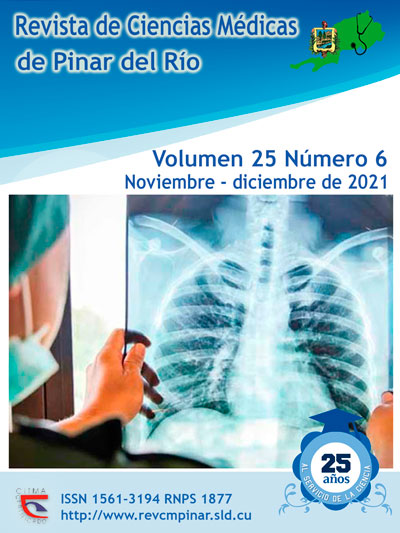Características clínicos-epidemiológicas del cólico renal séptico y su manejo terapéutico
Palabras clave:
CÓLICO RENAL, SÉPSIS, OBSTRUCCIÓN..Resumen
Introducción: el cólico renal séptico es producido por un cálculo obstructivo de la vía urinaria el cual se complica con la localización de gérmenes en la orina retenida en el tracto urinario
Objetivo: caracterizar el comportamiento clínico, epidemiológico y manejo terapéutico de los pacientes con cólico renal séptico en Pinar del Río, entre 2016 y 2019.
Método: se realizó una investigación observacional, descriptiva, con un universo de 186 pacientes, la muestra quedó conformada por 124 pacientes. Se recopilaron de las historias clínicas los datos siguientes: edad, sexo, causas y formas clínicas del cólico renal séptico, así como el tratamiento empleado. Se confeccionó una base de datos donde las variables cualitativas se expresaron en frecuencias absolutas y las relativas en porcientos.
Resultados: se encontró predominio de la quinta y tercera década de vida con 22,6 % y 21,0 % de pacientes respectivamente, el 60,5 % correspondió al sexo masculino. El 89,5 % presentaron litiasis renal como causa predominante, el cólico renal febril fue la forma clínica más frecuente. La mayoría fue tratada con cefalosporinas (96,8 %) y nitronidazoles (95,2 %). Resolvieron mediante cirugía endoscópica el 69,9 % y dentro de esta, la nefrostomía percutánea con el 54,2 %.
Conclusiones: el cólico nefrítico séptico fue más frecuente en la quinta década de la vida en el sexo masculino, el cólico renal febril fue la forma clínica y la litiasis como causa más frecuente, en la mayoría de los pacientes se empleó la cirugía endoscópica para su resolución con la aplicación de antimicrobianos cefazolinas y nitromidazol.
Descargas
Citas
1. Bacallao Méndez RA, Victores Aguiar I, Mañalich Comas R, Gutiérrez García F, Llerena Ferrer B, Almaguer López M. Caracterización clínico epidemiológica de la litiasis urinaria en un área rural de Artemisa. Rev. Cubana Invest Bioméd [Internet]. 2016 [citado: 03/12/2020]; 35(4): 300-10. Disponible en: http://scielo.sld.cu/scielo.php?script=sci_arttext&pid=S0864-03002016000400001&lng=es.
2. Türk C, Knoll T, Petrik A. Guidelines on Urolithiasis [Internet]. European Association of Urology; 2018 [citado: 14/01/2020]: 1-82. Disponible en: https://uroweb.org/wp-content/uploads/EAU-Guidelines-on-Urolithiasis-2018-large-text.pdf
3. Sánchez Bermeo A, Arellano Cuadros JR, García Cruz S, Torres Aguilar J, Reyes Vela C. Experiencia inicial nefrolitotomía percutánea, posición de Valdivia modificada para el tratamiento quirúrgico en pacientes con litiasis renal. Revista Mexicana de Urología [Internet]. 2015 [citado: 03/12/2020]; 75(5): 266-71. Disponible en: https://www.sciencedirect.com/science/article/pii/S2007408515001007
4. Ferrer Moret S, Pérez Morales D. Actualización en el tratamiento de la litiasis renal. Boletin de información terapéutica [Internet]. 2018 [citado: 03/12/2020]; 29(4):21-8. Disponible en: https://www.fundacionfemeba.org.ar/blog/farmacologia-7/post/actualizacion-en-el-tratamiento-de-la-litiasis-renal-bit-45712
5. Aguilar Cárdenas Y, Sánchez Maya A. Maniobras intervencionistas de urgencias en el cólico nefrítico. Rev Cub de Urol [Internet]. 2018 [citado: 03/08/2019]; 7. Disponible en: http://www.revurologia.sld.cu/index.php/rcu/article/view/441
6. Kirkali Z, Rasooly RA, Star R, Rodgers GP. Uninary Stone Disease: Progress, Status, and Needs. Urology [Internet]. 2015 [citado: 03/08/2019]; 86(4): 651-53. Disponible en: https://www.ncbi.nlm.nih.gov/pmc/articles/PMC4592788/
7. Mirfazaelian H, Doosti-Irani A, Jalili M, Thiruganasambandamoorthy V. Application of decision rules on diagnosis and prognosis of renal colic: a systematic review and meta-analysis. Eur J Emerg Med [Internet]. 2020 [citado: 18/04/2021]; 27(2): 87-93. Disponible en: https://pubmed.ncbi.nlm.nih.gov/31356369/
8. Lavergne O, Bonnet Q, Thomas A, Waltregny D. How I treat. A renal colic. Rev Med Liege [Internet]. 2016 [citado 10/02/2020]; 71(5): 220-6. Disponible en: https://pubmed.ncbi.nlm.nih.gov/27337839/
9. McCafferty G, Shorette A, Singh S, Budhram G. Emphysematous Pyelonephritis: Bedside Ultrasound Diagnosis in the Emergency Department. Clin Pract Cases Emerg Med [Internet]. 2017 [citado: 10/02/2020]; 1(2): 92-4. Disponible en: https://www.ncbi.nlm.nih.gov/pmc/articles/PMC5965426/
10. Navas A, Brazon Y. Pielonefritis enfisematosa en una paciente con diabetes mellitus tipo 2. Med. Interna (Caracas) [Internet]. 2017 [Citado: 10/02/2020]; 33(4): 215. Disponible en: https://svmi.web.ve/ojs/index.php/medint/article/view/441
11. Morehead MS, Scarbrough C. Emergence of Global Antibiotic Resistance. Prim Care [Internet]. 2018 [Citado: 04/03/2020]; 45(3): 467-84. Disponible en: https://pubmed.ncbi.nlm.nih.gov/30115335/
12. Curhan G, Aronson M, Preminger G. Diagnosis and acute management of suspected nephrolithiasis in adults [Internet]. UpToDate; 2021 [Citado 04/03/2020]. Disponible en: https://www.uptodate.com/contents/kidney-stones-in-adults-diagnosis-and-acute-management-of-suspected-nephrolithiasis#H2698242
13. Fiterre Lancis I, Sabournin Casteinau N, Sanchez Tamaki R, Molina Alfonso S, Bandera Sánchez Osladis, Aguilar Quintanó I, et al. Incidencia de infección y prácticas de uso de antimicrobianos en Urología de un hospital especializado. Rev Cubana Farm [Internet]. 2015 [citado: 01/03/2021]; 49(4). Disponible en: http://scielo.sld.cu/scielo.php?script=sci_arttext&pid=S0034-75152015000400007&lng=es
14. Shellikeri S, Daulton R, Sertic M, Connolly B, Hogan M, Marshalleck F, et al. Pediatric Percutaneous Nephrostomy: A Multicenter Experience. Vasc Interv Radiol [Internet]. 2017 [Citado: 04/03/2020]; 29(3): 328-334. Disponible en: https://www.ncbi.nlm.nih.gov/pubmed/29221922
15. Rodríguez Pastoriza R, Agüero Gómez JL. Uso de la nefrostomía percutánea en pacientes con insuficiencia renal obstructiva. Rev. Cubana Urol [Internet]. 2019 [citado: 21/08/2020]; 8(1): [aprox. 7p.]. Disponible en: http://www.revurologia.sld.cu/index.php/rcu/article/view/479
16. Caravia Pubillones I, Sánchez González ME, Reyes Arencibia RP. Nefrostomía combinada en las obstrucciones del tracto urinario superior. Rev. Cubana Urol [Internet]. 2019 [citado: 20/08/2020]; 8(1): [aprox. 3p.]. Disponible en: http://www.revurologia.sld.cu/index.php/rcu/article/view/429
17. Sandberg JM, Dyer RB, Mirzazadeh M. A Rare Case Report of Hydronephrosis and Acute Kidney Injury Secondary to Gonadal Vein Thrombosis in a Young Male. J Endourol Case Rep [Internet]. 2017 [citado: 20/08/2020]; 3(1): 119-122. Disponible en: https://www.ncbi.nlm.nih.gov/pmc/articles/PMC5628569/
Publicado
Cómo citar
Número
Sección
Licencia
Aquellos autores/as que tengan publicaciones con esta revista, aceptan los términos siguientes:- Los autores/as conservarán sus derechos de autor y garantizarán a la revista el derecho de primera publicación de su obra, el cuál estará simultáneamente sujeto a la Licencia de reconocimiento de Creative Commons que permite a terceros compartir la obra siempre que se indique su autor y su primera publicación esta revista.
- Los autores/as podrán adoptar otros acuerdos de licencia no exclusiva de distribución de la versión de la obra publicada (p. ej.: depositarla en un archivo telemático institucional o publicarla en un volumen monográfico) siempre que se indique la publicación inicial en esta revista.
- Se permite y recomienda a los autores/as difundir su obra a través de Internet (p. ej.: en archivos telemáticos institucionales o en su página web) antes y durante el proceso de envío, lo cual puede producir intercambios interesantes y aumentar las citas de la obra publicada. (Véase El efecto del acceso abierto).



